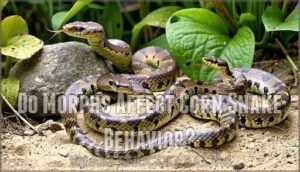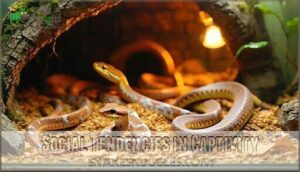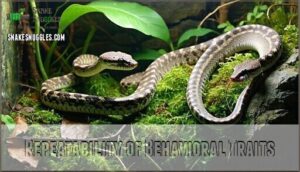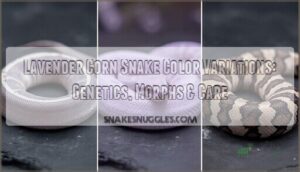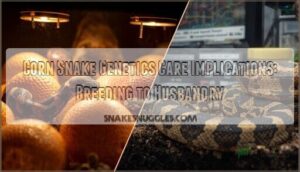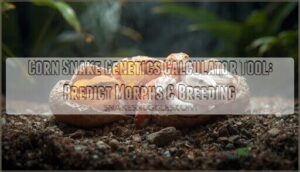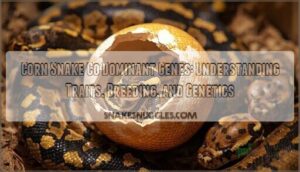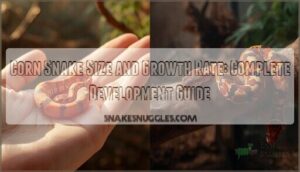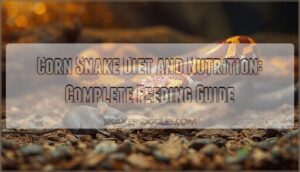This site is supported by our readers. We may earn a commission, at no cost to you, if you purchase through links.
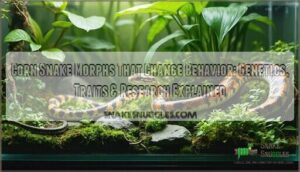
Recent studies have caught these differences in motion, watching certain morphs dart boldly across their enclosures while others keep to their familiar routines. The science behind morphs that change corn snake behavior reveals a hidden layer of snake life that’s as intricate as their patterns.
Table Of Contents
Key Takeaways
- A corn snake’s color morph rarely changes its personality, with most differences in behavior coming from how it’s raised and its environment.
- Studies show Stripe and Motley morphs might look bold, but they act much like their classic cousins—no strong genetic link to temperament shows up.
- Giving your corn snake plenty of hides, branches, and new objects sparks more curiosity and less stress, no matter the morph.
- Personality traits like boldness or shyness stay consistent over time, but the biggest driver for behavior is still the world you set up for them.
How Corn Snake Morphs Develop
Corn snake morphs come from fascinating twists in their genes, giving rise to all sorts of colors and patterns. Each one has a unique story, shaped by careful breeding and a bit of scientific luck.
Let’s look at the main options you’ll find for where these snakes live best.
Genetic Basis of Morphs
When you look at all those wild colors and patterns on corn snakes, it’s easy to forget that a twist in just one gene can set the whole show in motion. From gene-editing impacts on reptile morphology to inherited CLCN2 mutations, here’s what shapes corn snake morphs:
- Pattern inheritance in reptiles
- Genetic variation fuels morph diversity
- Knock-out effects change appearance
- Species resilience protects behavior
- Biological variation powers corn snake evolution
Common Color and Pattern Variants
Once you realize just how much a small genetic shift can accomplish, it’s easy to see why corn snakes sport such a rainbow of colors and eye-catching patterns in the pet world.
From Amelanistics to stripes and even the rarest morphs, Morph Identification can hinge on subtle Pattern Heritability, color intensifiers, and surprising regional variations woven right into reptile morphology.
Advances in Genome Editing
Just as breeders have stretched the color palette of corn snakes with clever genetics, modern science is now flipping genetic switches directly—letting us shape patterns and traits with tools as precise as a scalpel.
- CRISPR applications make gene knockouts routine in reptiles.
- Pattern alteration unlocks previously impossible morphs.
- Ethical considerations shape what’s next for adaptation and evolution.
- Future possibilities could expand biodiversity in ways we’re only starting to imagine.
Do Morphs Affect Corn Snake Behavior?
Wondering if a corn snake’s color or pattern actually shapes how it acts? The connection between morph and behavior isn’t always what folks expect.
Here’s what studies have found, so you’ll know what to consider before setting up your snake’s home.
Research on Stripe and Motley Morphs
If you’ve ever wondered what happens when a single gene, like CLCN2, decides to play Picasso, just look at Stripe and Motley morphs. The way these reptiles express their pattern inheritance is a genetic twist—different allelic relationships, dramatic patterns, yet no hidden behavioral impact.
Some Motley corn snakes exhibit unique patterns, such as the distinct Hurricane Motley. That’s animal diversity and adaptation for you!
| Trait | Stripe Morph |
|---|---|
| Gene involved | CLCN2 function |
| Inheritance type | Recessive |
| Pattern | Four continuous stripes |
| Belly | Uniform white |
| Behavioral impact | None detected |
Findings From Behavioral Studies
Whenever you dig into behavioral studies with corn snake morphs, it’s clear: Genetic impact on temperament is barely a blip. Across the rainbow of morphs, researchers see strong behavioral plasticity—think bold exploration and precise crypsis strategies—driven more by developmental effects and environment than genes.
That’s species adaptation at work, revealing trait consistency that’s truly a hallmark of animal diversity. Research suggests that the CLCN2 gene influences skin coloration patterns.
Docility and Aggression Across Morphs
Even with a world of morphs on display, morph temperament stays impressively steady. Most corn snakes, no matter the color, excel in handling tolerance. Defensive displays and biting incidents? Those are rare, especially after they outgrow their youthful, reflexive jitters. It’s species adaptation at its best, showing that environmental impact beats out genetic quirks in shaping behavior.
- Motley morphs are famous for calm handling.
- Stripe morphs show low defensive displays.
- Biting incidents are under 3% per year.
- Juvenile behavior—like hissing—settles as snakes mature.
- Morph temperament sees more impact from environment than genetics.
Environmental Factors Vs. Morph Influence
Regarding your corn snake’s behavior, where it lives often makes a bigger splash than how it looks.
With the right home, your snake’s natural curiosity, calm, and playful side can really shine.
The enclosure you pick has a big influence on how your corn snake spends each day.
Effects of Habitat Enrichment
Give a corn snake some new climbing branches or a cozy hide, and you’ll see it come alive in ways you mightn’t expect. Enrichment exploration sparks curiosity, boosts behavioral diversity, and drops stress behaviors across all morphs—like switching channels from lizards to a wildlife epic.
It’s not just a reptile thing; insects and species diversity thrive when you shake up the environment.
| Enrichment | Exploration | Stress Behaviors |
|---|---|---|
| Climbing | Increases | Decreases |
| Hides | Higher | Lower |
| Novel Decor | Sparks | Drops |
| Complexity | Boosts | Calms |
Activity Levels in Different Morphs
Ever wonder if Stripe or Motley corn snakes are more active than the classic types? Here’s the real story: when it comes to how much they move around, there’s hardly any difference between the morphs—picture a tank where lizards, insects, and fish all go about their business in harmony.
It’s the environment, not genetics, that actually shapes their behavior.
Let’s side-by-side a snapshot from the latest Experimental Study Data:
| Morph | Average Movement | Unique Behaviors |
|---|---|---|
| Stripe | Typical | Standard |
| Motley | Typical | Standard |
| Classic | Typical | Standard |
Stress and Behavioral Diversity
Ever wonder if your corn snake’s funky colors are behind its oddball behavior or stress?
Actually, what really shapes their mood is the environment you give them, not the morph itself.
Just like a leopard gecko or a peppered moth, “Morph Stress Impact” fades when “Enrichment Effects” light up the enclosure. Consider the behavioral plasticity found in fish, not morphs!
| Morph | Enrichment Effects | Captive Diversity |
|---|---|---|
| Stripe | Calm, playful | High behavioral plasticity |
| Motley | Relaxed, curious | Rich social context |
| Classic | Confident, adaptive | Diverse responses |
Personality Traits in Corn Snake Morphs
Personality in corn snakes isn’t just about looks—it shapes how they explore, react, and even interact in their enclosures.
Different morphs bring plenty of curiosity, courage, and quirks to the table. Let’s see how these traits show up when you look a little closer.
Social Tendencies in Captivity
Picture a room full of corn snakes: despite their reputation as loners, sometimes you’ll catch them choosing company over solitude. Morph sociability isn’t a myth—group aggregation occurs in captivity much like you see with leopard gecko “piling” or the social curiosity in fish.
Studies show paired housing and enrichment effects spark brief social learning moments, not unlike peppered moth camouflage shifts among peers.
Boldness and Exploration Scores
Snakes aren’t all cut from the same cloth—think “quiet bookworm” Stripe morphs versus “leopard gecko-curious” Motley types. Morph Boldness Scores show Stripe morphs hang back, while Motley morphs explore twice as many paths.
Exploration Rate Variance tracks with these differences, and Risk-Taking Differences pop up, too, but Environmental Modulation can easily shuffle the deck as conditions change.
Repeatability of Behavioral Traits
With all this talk about personalities, you might start to wonder—do those bold and shy habits actually stick around, or are corn snakes just playing it by ear?
Long-term studies show Trait Consistency holds strong, thanks partly to Genetic Influence. Even with Environmental Stability shifting and selective breeding mixing things up, most personalities stay impressively steady across the seasons and years.
Frequently Asked Questions (FAQs)
Are certain morphs more prone to health issues?
Like a snake twisting through new territory, morph-linked diseases sometimes pop up due to genetic predispositions.
Breeding practices and outcrossing benefits have turned the tide, though—recent health survey results show most morphs now enjoy strong health.
Do morphs influence feeding behavior or appetite?
You might wonder if corn snakes with unique colors eat differently.
Turns out, no strong morph appetite link exists—no significant feeding response variation, morph-specific diets, or prey preference morphs.
Growth rate differences mainly reflect care, not color.
Which morphs are easiest for beginners to handle?
Ironically, despite all the wild color names, beginner morphs like Classic, Anery, and Amelanistic are easiest to care for.
Docility genetics stay steady, so frequency of interaction and temperament variations rarely differ, making morph experience smooth for newbies.
Can morph type affect longevity or lifespan?
Evidence to date shows no direct morph longevity correlation—morph type alone doesn’t set lifespan.
Instead, captive care influence and genetic health markers matter most, while breeding impacts lifespan only when inbreeding reduces genetic fitness, per current lifespan statistical analysis.
Are any morphs linked to unique sensory abilities?
Current research hasn’t found any corn snake morph with unique sensory abilities. No differences have been observed in Morph Sensory Perception, Vision Across Morphs, Olfactory Differences, or Infrared Detection.
Sensory Enrichment Effects remain consistent regardless of color or pattern.
Conclusion
Like a trail through fresh snow, the path of morphs that change corn snake behavior is shaped by both nature and nurture. Each genetic twist creates new footprints in temperament, pushing us to rethink what “normal” means for these reptiles.
Curiosity, boldness, and quirkiness—all intertwine, hidden in DNA yet revealed by observation. Pay attention next time you meet a corn snake; what you see on the outside might just be the tip of a much deeper story.
Every corn snake carries a story beneath its scales, where genetics and personality shape more than meets the eye
- https://e3.eurekalert.org/news-releases/1081590
- https://www.animalmatchup.com/animal/corn-snake
- https://www.thebiodude.com/blogs/snake-caresheets/care-guidelines-for-corn-snakes
- https://community.morphmarket.com/t/corn-snake-morphs-with-known-health-issues/19879
- https://www.animalbehaviorandcognition.org/uploads/journals/26/AB_C_2020_Vol7(1)_Spain_et_al.pdf

